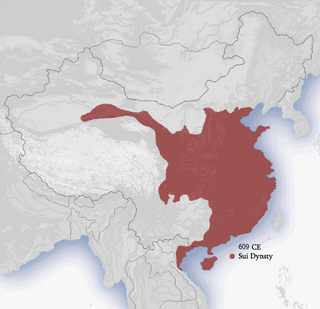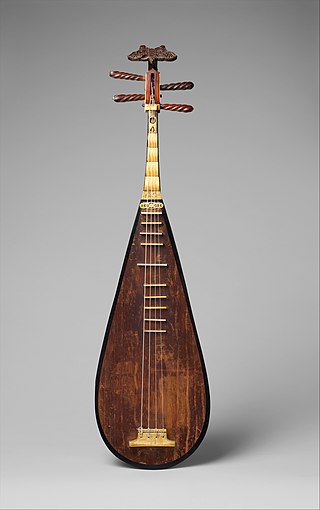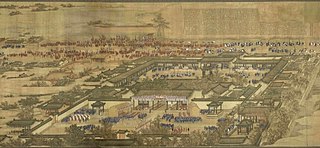Related Research Articles

The Sui dynasty was a short-lived imperial dynasty of China that lasted from 581 to 618. The Sui unified the Northern and Southern dynasties, thus ending the long period of division following the fall of the Western Jin dynasty, and laying the foundations for the much longer lasting Tang dynasty.

The Xianbei were most likely a Proto-Mongolic ancient nomadic people that once resided in the eastern Eurasian steppes in what is today Mongolia, Inner Mongolia, and Northeastern China. There are also other strong suggestions that they were a multi-ethnic confederation with Mongolic and Turkic influences. They originated from the Donghu people who splintered into the Wuhuan and Xianbei when they were defeated by the Xiongnu at the end of the third century BC. The Xianbei were largely subordinate to larger nomadic powers and the Han dynasty until they gained prominence in 87 AD by killing the Xiongnu chanyu Youliu. However unlike the Xiongnu, the Xianbei political structure lacked the organization to pose a concerted challenge to the Chinese for most of their time as a nomadic people.

The regular script, also called 正楷, 真書 (zhēnshū), 楷體 (kǎitǐ) and 正書 (zhèngshū), is the newest of the Chinese script styles. It is the most common style in modern writings and third most common in publications.

The pipa, pípá, or p'i-p'a is a traditional Chinese musical instrument belonging to the plucked category of instruments. Sometimes called the "Chinese lute", the instrument has a pear-shaped wooden body with a varying number of frets ranging from 12 to 31. Another Chinese four-string plucked lute is the liuqin, which looks like a smaller version of the pipa. The pear-shaped instrument may have existed in China as early as the Han dynasty, and although historically the term pipa was once used to refer to a variety of plucked chordophones, its usage since the Song dynasty refers exclusively to the pear-shaped instrument.

Han Sui, courtesy name Wenyue, was a military general and minor warlord who lived during the late Eastern Han dynasty of China. For most of his life, he was active in Liang Province and was involved in several rebellions against the Han government and the warlord Cao Cao.
Heqin, also known as marriage alliance, refers to the historical practice of Chinese monarchs marrying princesses—usually members of minor branches of the ruling family—to rulers of neighboring states. It was often adopted as an appeasement strategy with an enemy state that was too powerful to defeat on the battlefield. The policy was not always effective. It implied an equal diplomatic status between the two monarchs. As a result, it was controversial and had many critics.

Shuowen Jiezi is an ancient Chinese dictionary compiled by Xu Shen during the Eastern Han dynasty. Although not the first comprehensive Chinese character dictionary, it was the first to analyze the structure of the characters and to give the rationale behind them, as well as the first to use the principle of organization by sections with shared components called radicals.

Cai Yan, courtesy name Wenji, was a Chinese composer, poet, and writer who lived during the late Eastern Han dynasty of China. She was a daughter of Cai Yong. Her courtesy name was originally Zhaoji, but was changed to Wenji during the Jin dynasty to avoid naming taboo because the Chinese character for zhao in her courtesy name is the same as that in the name of Sima Zhao, the father of the Jin dynasty's founding emperor, Sima Yan. She spent part of her life as a captive of the Xiongnu until 207, when the warlord Cao Cao, who controlled the Han central government in the final years of the Eastern Han dynasty, paid a heavy ransom to bring her back to Han territory.

The Thousand Character Classic, also known as the Thousand Character Text, is a Chinese poem that has been used as a primer for teaching Chinese characters to children from the sixth century onward. It contains exactly one thousand characters, each used only once, arranged into 250 lines of four characters apiece and grouped into four line rhyming stanzas to make it easy to memorize. It is sung, much as children learning the Latin alphabet sing an "alphabet song." Along with the Three Character Classic and the Hundred Family Surnames, it has formed the basis of literacy training in traditional China.

The Hanlin Academy was an academic and administrative institution of higher learning founded in the 8th century Tang China by Emperor Xuanzong in Chang'an.

The Fourth Era of Northern Domination was a period of Vietnamese history, from 1407 to 1427, during which Vietnam was ruled by the Chinese Ming dynasty as the province of Jiaozhi. Ming rule was established in Vietnam following its conquest of the Hồ dynasty. The previous periods of Chinese rule, collectively known as Bắc thuộc, lasted much longer and amounted to around 1000 years. The fourth period of Chinese rule over Vietnam was eventually ended with the establishment of the Later Lê dynasty.
Yan Xiang, courtesy name Wenze, was an official who lived during the late Eastern Han dynasty of China. A similarly named Yan Xiang (閻象) also served under the warlord Yuan Shu as a registrar. Although it is not clear whether they were the same person, the historian Rafe de Crespigny mentioned that it could be assumed that Yan Xiang left Yuan Shu and defected to the Han central government, which was then under the leadership of the warlord Cao Cao.

Ji Ben was an imperial physician who lived during the late Eastern Han dynasty of China. In 218, he started a rebellion with several others in the imperial capital, Xu, but the revolt was suppressed and the conspirators were captured and executed.
The literary inquisition, also known as speech crime (以言入罪), refers to official persecution of intellectuals for their writings in China. The Hanyu Da Cidian defines it as "the ruler deliberately extracts words or phrases from intellectual's writings and arbitrarily accuse him in order to persecute him" ("旧时谓统治者为迫害知识分子,故意从其著作中摘取字句,罗织成罪"). The inquisition took place under each of the dynasties ruling China, although the Ming dynasty was particularly notorious for the practice. In general, there are two ways a literary inquisition could be carried out. First is that the conviction came from the writing itself. That is, the writing was the direct cause of the persecution. The second is that the writing was used as a tool to provide legitimate evidence for a predetermined conviction. Such persecutions could owe even to a single phrase or word which the ruler considered offensive. Some of these were due to the naming taboo, such as writing a Chinese character that was part of the emperor's personal name. In the most serious cases, not only the writer, but also their immediate and extended families, as well as those close to them, would also be implicated and killed.
Emperor Jing of Western Liang, personal name Xiao Cong (蕭琮), courtesy name Wenwen (溫文), known during the Sui dynasty as the Duke of Ju (莒公) then Duke of Liang (梁公), was the final emperor of the Western Liang dynasty of China. He died c.September 607, by which time he was at least into middle age. Both he and his father Emperor Ming heavily relied on the military support of the Sui. In 587, after Emperor Jing's uncle Xiao Yan (蕭巖) and brother Xiao Huan (蕭瓛), surrendered to the Chen dynasty after suspecting Sui intentions, the Emperor Wen of Sui abolished the Western Liang throne, seized Western Liang territories, and made Emperor Jing one of his officials, thus ending the Western Liang dynasty.

The Wen Xuan, usually translated Selections of Refined Literature, is one of the earliest and most important anthologies of Chinese poetry and literature, and is one of the world's oldest literary anthologies to be arranged by topic. It is a selection of what were judged to be the best poetic and prose pieces from the late Warring States period to the early Liang dynasty, excluding the Chinese Classics and philosophical texts. The Wen Xuan preserves most of the greatest fu rhapsody and shi poetry pieces from the Qin and Han dynasties, and for much of pre-modern history was one of the primary sources of literary knowledge for educated Chinese.
傅 is an ancient Han Chinese surname of imperial origin which is at least 4,000 years old. The great-great-great-grandson of the Yellow Emperor, Dayou, bestowed this surname to his son Fu Yi and his descendants. Dayou is the eldest son of Danzhu and grandson of Emperor Yao.
The Shenglei 聲類, compiled by the Cao Wei dynasty lexicographer Li Deng 李登, was the first Chinese rime dictionary. Earlier dictionaries were organized either by semantic fields or by character radicals. The last copies of the Shenglei were lost around the 13th century, and it is known only from earlier descriptions and quotations, which say it was in 10 volumes and contained 11,520 Chinese character entries, categorized by linguistic tone in terms of the wǔshēng 五聲 "Five Tones " from Chinese musicology and wǔxíng 五行 "Five Phases/Elements" theory.
The Zilin or Forest of Characters was a Chinese dictionary compiled by the Jin dynasty (266–420) lexicographer Lü Chen (呂忱). It contained 12,824 character head entries, organized by the 540-radical system of the Shuowen Jiezi. In the history of Chinese lexicography, the Zilin followed the Shuowen Jiezi and preceded the Yupian.
References
- ↑ Zhang Zhibin, Paul Unschuld, ed. (2018). Dictionary of the Ben Cao Gang Mu. Vol. 3. University of California Press. p. 58. ISBN 9780520291973 . Retrieved 4 April 2021.
- ↑ 旧唐书列传第一百三十九 儒学上》
- ↑ Knechtges, David (1982). Wen Xuan Or Selections of Refined Literature. Vol. 1. Princeton University Press. p. 52. ISBN 9781400857241 . Retrieved 4 April 2021.